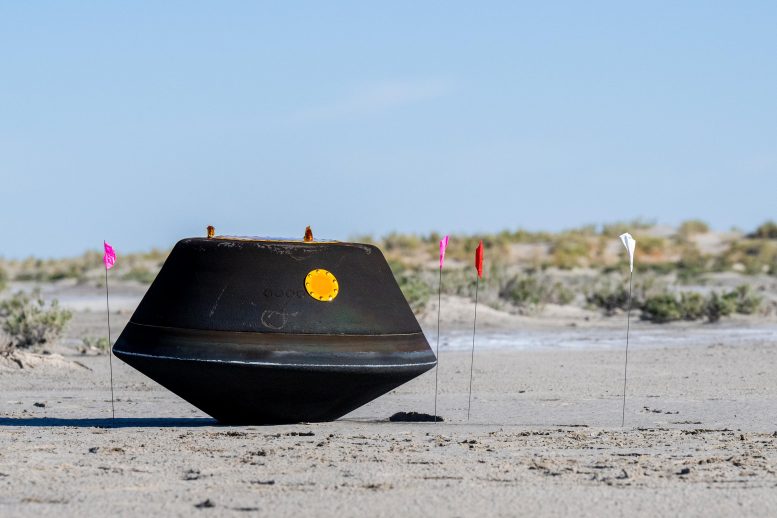NASA’s OSIRIS-REx team received the prestigious Goddard Memorial Trophy for its historic mission of collecting and returning an asteroid sample, aiding scientific research on the solar system’s origins.
NASA’s OSIRIS-REx team was selected as the winner of the National Space Club and Foundation’s 2024 Dr. Robert H. Goddard Memorial Trophy for their tremendous work on the first U.S. mission to bring an asteroid sample to Earth. The winning team received the award at the 67th Annual Robert H. Goddard Memorial Dinner at the Washington Hilton Hotel on March 22, 2024.
The OSIRIS-REx (Origins, Spectral Interpretation, Resource Identification, and Security – Regolith Explorer) team includes NASA’s Goddard Space Flight Center in Greenbelt, Maryland; Lockheed Martin in Littleton, Colorado; University of Arizona, Tucson and KinetX in Tempe, Arizona.
The trophy is National Space Club’s highest honor and presented annually to the individual or group who has made a substantial contribution to U.S. leadership in astronautics or rocketry.
“The OSIRIS-REx team’s successful delivery of the asteroid Bennu sample to Earth will enable important scientific discoveries for generations to come,” said Lori Glaze, director of the Planetary Science Division at NASA Headquarters in Washington. “I’m so pleased to see the mission team recognized with the Robert H. Goddard Memorial Trophy for their accomplishments.”

The sample return capsule from NASA’s OSIRIS-REx mission is seen shortly after touching down in the desert, Sunday, September 24, 2023, at the Department of Defense’s Utah Test and Training Range. The sample was collected from the asteroid Bennu in October 2020 by NASA’s OSIRIS-REx spacecraft. Credit: NASA/Keegan Barber
Making U.S. History
Following its launch in 2016, the OSIRIS-REx mission made U.S. space history when it became the first U.S. spacecraft to touch an asteroid and capture a sample on October 20, 2020, and again when it successfully returned with the sample to Earth on September 24, 2023.
The sample, which is the largest asteroid sample ever delivered to Earth, is from the ancient asteroid Bennu and will give researchers worldwide a glimpse into the earliest days of our solar system, offering insights into planet formation and the origin of organics that led to life on Earth. Data collected by the spacecraft combined with future analysis of the Bennu sample will also aid our understanding of asteroids that can impact Earth.
The OSIRIS-REx mission conducted unprecedented centimeter-scale mapping of Bennu, surpassing precision levels achieved for any other planetary body and setting three Guinness World Records for: smallest object orbited by a spacecraft, closest orbit of an asteroid and highest resolution satellite map of any planetary body.
“The OSIRIS-REx mission rewrote U.S. space exploration history,” said Joe Vealencis, president, NSCF. “The data the spacecraft collected, plus all that we have yet to uncover from the sample it brought back, means scientists and engineers will be reaping the benefits of this mission for years to come.”
The Mission Continues
Following its successful sample return, the OSIRIS-REx spacecraft was renamed OSIRIS-APEX and will now enter an extended mission to visit and study near-Earth asteroid Apophis in 2029.
OSIRIS-REx’s success was made possible by the unique contributions of over 1,000 individuals from government and mission partners like the science lead at the University of Arizona, the project team at NASA’s Goddard Space Flight Center, the curation team at NASA’s Johnson Space Center, spacecraft design, operations, and recovery by Lockheed Martin, guidance and navigation at KinetX, and the launch provider at United Launch Alliance.
OSIRIS-REx is the third mission in NASA’s New Frontiers Program, managed by NASA’s Marshall Space Flight Center in Huntsville, Alabama, for the Science Mission Directorate at NASA Headquarters in Washington.





